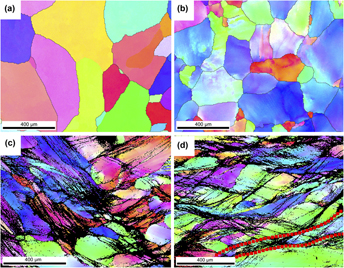Crossref Citations
This article has been cited by the following publications. This list is generated based on data provided by
Crossref.
Wu, Wenqian
Guo, Lin
Liu, Bin
Ni, Song
Liu, Yong
and
Song, Min
2017.
Effects of torsional deformation on the microstructures and mechanical properties of a CoCrFeNiMo0.15 high-entropy alloy.
Philosophical Magazine,
Vol. 97,
Issue. 34,
p.
3229.
Hu, Xiangli
and
Chen, Ding
2018.
Effect of Ceramic Rolling and Annealing on Mechanical Properties of AlCoCrFeNi2.1 Eutectic High-Entropy Alloys.
Journal of Materials Engineering and Performance,
Vol. 27,
Issue. 7,
p.
3566.
Yao, J.Q.
Liu, X.W.
Gao, N.
Jiang, Q.H.
Li, N.
Liu, G.
Zhang, W.B.
and
Fan, Z.T.
2018.
Phase stability of a ductile single-phase BCC Hf0.5Nb0.5Ta0.5Ti1.5Zr refractory high-entropy alloy.
Intermetallics,
Vol. 98,
Issue. ,
p.
79.
Stepanov, N.D.
Yurchenko, N.Yu.
Gridneva, A.O.
Zherebtsov, S.V.
Ivanisenko, Yu.V.
and
Salishchev, G.A.
2018.
Structure and hardness of B2 ordered refractory AlNbTiVZr0.5 high entropy alloy after high-pressure torsion.
Materials Science and Engineering: A,
Vol. 716,
Issue. ,
p.
308.
Eleti, R.R.
Raju, V.
Veerasham, M.
Reddy, S.R.
and
Bhattacharjee, P.P.
2018.
Influence of strain on the formation of cold-rolling and grain growth textures of an equiatomic HfZrTiTaNb refractory high entropy alloy.
Materials Characterization,
Vol. 136,
Issue. ,
p.
286.
Yurchenko, Nikita
Panina, Evgeniya
Zherebtsov, Sergey
Salishchev, Gennady
and
Stepanov, Nikita
2018.
Oxidation Behavior of Refractory AlNbTiVZr0.25 High-Entropy Alloy.
Materials,
Vol. 11,
Issue. 12,
p.
2526.
Zhang, Weiran
Liaw, Peter K.
and
Zhang, Yong
2018.
Science and technology in high-entropy alloys.
Science China Materials,
Vol. 61,
Issue. 1,
p.
2.
Stepanov, N.D.
Yurchenko, N.Yu.
Zherebtsov, S.V.
Tikhonovsky, M.A.
and
Salishchev, G.A.
2018.
Aging behavior of the HfNbTaTiZr high entropy alloy.
Materials Letters,
Vol. 211,
Issue. ,
p.
87.
Málek, Jaroslav
Zýka, Jiří
Lukáč, František
Čížek, Jakub
Kunčická, Lenka
and
Kocich, Radim
2019.
Microstructure and Mechanical Properties of Sintered and Heat-Treated HfNbTaTiZr High Entropy Alloy.
Metals,
Vol. 9,
Issue. 12,
p.
1324.
Yurchenko, N. Yu
Panina, E.S.
Zherebtsov, S.V.
Tikhonovsky, M.A.
Salishchev, G.A.
and
Stepanov, N.D.
2019.
Microstructure evolution of a novel low-density Ti–Cr–Nb–V refractory high entropy alloy during cold rolling and subsequent annealing.
Materials Characterization,
Vol. 158,
Issue. ,
p.
109980.
Manzoni, Anna M.
and
Glatzel, Uwe
2019.
New multiphase compositionally complex alloys driven by the high entropy alloy approach.
Materials Characterization,
Vol. 147,
Issue. ,
p.
512.
Qin, Gang
Li, Zibo
Chen, Ruirun
Zheng, Huiting
Fan, Chenlei
Wang, Liang
Su, Yanqing
Ding, Hongsheng
Guo, Jingjie
and
Fu, Hengzhi
2019.
CoCrFeMnNi high-entropy alloys reinforced with Laves phase by adding Nb and Ti elements.
Journal of Materials Research,
Vol. 34,
Issue. 6,
p.
1011.
Murty, B.S.
Yeh, J.W.
Ranganathan, S.
and
Bhattacharjee, P.P.
2019.
High-Entropy Alloys.
p.
145.
Xiao, Yifeng
Kuang, Wenhui
Xu, Yanfei
Wu, Liang
Gong, Wenjuan
Qian, Jinwen
Zhang, Qiankun
and
He, Yuehui
2019.
Microstructure and oxidation behavior of the CrMoNbTaV high-entropy alloy.
Journal of Materials Research,
Vol. 34,
Issue. 2,
p.
301.
Eleti, Rajeshwar R.
Bhattacharjee, Tilak
Shibata, Akinobu
and
Tsuji, Nobuhiro
2019.
Unique deformation behavior and microstructure evolution in high temperature processing of HfNbTaTiZr refractory high entropy alloy.
Acta Materialia,
Vol. 171,
Issue. ,
p.
132.
Couzinié, J.-P.
and
Dirras, G.
2019.
Body-centered cubic high-entropy alloys: From processing to underlying deformation mechanisms.
Materials Characterization,
Vol. 147,
Issue. ,
p.
533.
Yang, Cheng
Aoyagi, Kenta
Bian, Huakang
and
Chiba, Akihiko
2019.
Microstructure evolution and mechanical property of a precipitation-strengthened refractory high-entropy alloy HfNbTaTiZr.
Materials Letters,
Vol. 254,
Issue. ,
p.
46.
2019.
High-Entropy Alloys.
p.
299.
Sha, Chuhan
Zhou, Zhifeng
Xie, Zonghan
and
Munroe, Paul
2020.
FeMnNiCoCr-based high entropy alloy coatings: Effect of nitrogen additions on microstructural development, mechanical properties and tribological performance.
Applied Surface Science,
Vol. 507,
Issue. ,
p.
145101.
Zherebtsov, Sergey
Yurchenko, Nikita
Shaysultanov, Dmitry
Tikhonovsky, Mikhail
Salishchev, Gennady
and
Stepanov, Nikita
2020.
Microstructure and Mechanical Properties Evolution in HfNbTaTiZr Refractory High‐Entropy Alloy During Cold Rolling.
Advanced Engineering Materials,
Vol. 22,
Issue. 10,






